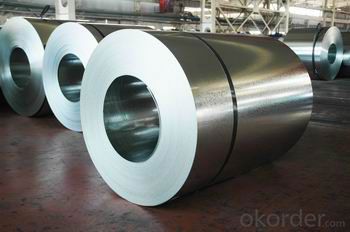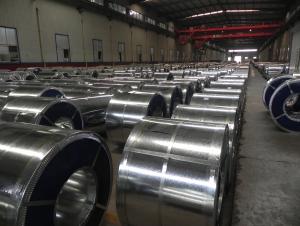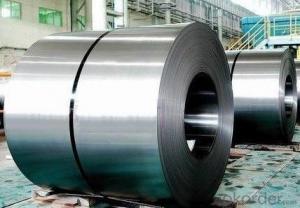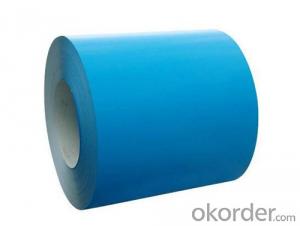Galvanized STEEL Coils
- Loading Port:
- China Main Port
- Payment Terms:
- TT OR LC
- Min Order Qty:
- -
- Supply Capability:
- -
OKorder Service Pledge
OKorder Financial Service
You Might Also Like
Steel Specification:
Thickness: 0.2-3.0mm
Width: 600-1500mm
Coating :
Zinc Coating Weight Symbol | AZ 06 | AZ08 | AZ 13 | AZ 12 | AZ 18 | AZ 20 | AZ 22 | AZ 26 | AZ 27 |
Zinc Coating Thickness (mm) | 0.013 | 0.017 | 0.021 | 0.026 | 0.034 | 0.040 | 0.043 | 0.049 | 0.054 |
Weight g/㎡ (both sides) | 90 | 120 | 125 | 183 | 244 | 285 | 305 | 345 | 381 |
ASTM A 525 | G-30 |
| G-40 | G-60 |
| G-90 |
|
| G-115 |
Tolerance for thickness,width,flatness and so on conform to the requirements of JIS G3302 or ASTM A653M/924M
Coil ID can be either 508mm or 610mm, maximum coil OD is 2000mm
The speicfication of ASTM Such as A653m,A924 M and so on have been updated to the latest revisions
Excellent film adhesion
The coating layer is manufactured with fine porous surfaces so as to be high in surface vitality and be very excellent in film adhesion without phosphate treatment.
Excellent corrosion resistance
The surface layer is finer and harder than electrically galvanized steel sheets by using a hot-dip coating method so as to be excellent in white rust resistance at constant temperature and humidity as well as in red rust resistance. Especially, the adhesion with paint is good so as to be very excellent in paint corrosion resistance.
Excellent powdering resistance
This is manufactured in a short time heating and long time heat treatment method so as to be very excellent in powdering resistance.
Diverse mechanical property and high formability
The passing length of heating, crack and cooling zone of furnace before coating is made longer than the existing equipment so as to secure diverse mechanical property and high formability so that diverse desires of consumers can be satisfied.
Beautiful appearance
The flatness equal to the cold rolled steel sheet was realized by completely removing unevenness in the surface layer occurring during iron-zinc alloy using a temper rolling mill of high pressure load ratio after coating. Besides, this has no spangle and has a white gray color similar to EGI so as to be very beautiful in appearance
Corrosion resistance
The improved corrosion resistance of 55% AI-Zn alloy-coated steel coils is derived from the unique combination of the barrier protection of the aluminum and the sacrificial protection of the zinc. The formation of an insoluble aluminum oxide layer provides the barrier protection while the zinc provides a sacrificial protection at cut edges, scratches and areas of coating damage. Outdoor exposure testing of 55% AI-Zn alloy-coated steel onus has been conducted for over 20 years in various atmospheric environments. This testing also demonstrated a superior cut edge protection of 55% AI-Zn alloy-coated steel sheet than the galvanized steel sheet.
Heat resistance
Similar to the aluminum coated steel sheet that can resist high temperature oxidation, 55% AI-Zn alloy-coated steel sheet demonstrates better resistance to high temperature than the galvanized steel sheet.Benlog 55% AI-Zn alloy-coated steel sheet can be used in temperatures up to 315ºC.
Heat transmission and reflectivity
55% AI-Zn alloy-coated steel coil has a high reflectivity value making it an effective barrier against heat.
Surface Treatment:
Chromate treatment,Oiled or Anti-finger print
Surface Finished:
REGULAR SPANGLE:
Regular spangle is also called normal spangle which is naturally formed without any additional treatment during galvanizing.
MINI SPANGLE:
The spangle is restrained and formed as mini spangle by reducing the lead content in the zinc liquid or by blowing the zinc powder from the equipment installed on the zinc pot.
EXTRA SMOOTH:
The mini spangle is further skin-passed to produce the extra smooth surface
Application:
BUILDING & CONSTRUCTION
Floor decks, ceilings, verandas, rolling doors, warehouse, partitions, sheds, gutters, wall, underground piping, sashes, beams, fences, scaffolding, indoor decorations, ducts, ventilating pipes, steel frames and cable trays.
ELECTRICAL APPLIANCES
Freezers, video recorder cases, motor cases, lighting fittings, water heaters, washing machines, refrigerators, stoves, air conditioners, dehumidifiers, fluorescent light housings, electrical heaters, toasters, microwave oven enclosures and switch boxes.
TRANSPORTATION
Containers, under body panels, bus & truck body panels, fuel tanks, noise screens, highway signs, air cleaners, conveyor systems and guard rails.
AGRICULTURAL EQUIPMENT
Barns, drying machines, animal houses, hoppers, irrigation systems, greenhouses, water tanks, sheds, silos, agricultural implements and feeders.
FURNITURE & OTHERS
Vending machines, drums, cans, pails, sauna inner parts, chimney pipes, entertainment machines, solar collectors, office equipment, steel furniture, tool boxes, garages and waste bins.
COMPUTER'S APPLIANCES
Computer shells and communication instruments。
- Q: What are the different methods of transporting steel coils?
- Depending on factors such as weight, size, and distance, there are various methods available for transporting steel coils. These include: 1. Flatbed trucks: Steel coils can be transported on flatbed trucks, which have a spacious open platform for easy loading and unloading. This option is commonly used for shipments of short to medium distances and provides convenient access to the coils. 2. Rail transport: Steel coils can also be transported by rail using specialized coil cars with curved interiors to securely hold the coils. Rail transport is often preferred for long-distance shipments due to its cost-effectiveness and capacity to handle large quantities. 3. Shipping containers: Steel coils can be loaded into shipping containers for transportation via sea or inland waterways. To prevent movement during transit, the coils are usually secured inside the container using bracing or blocking materials. This method is commonly employed for international shipments and facilitates easy handling and transfer between different modes of transportation. 4. Barges: In some cases, steel coils can be transported on barges along rivers, canals, or other inland waterways. Barges are particularly suitable for large and heavy shipments, offering a cost-effective and efficient means of transportation. 5. Roll-on/roll-off (RoRo) vessels: RoRo vessels are specialized ships designed to transport vehicles and large cargo that can be rolled on and off the ship. Steel coils can be loaded onto trailers or flatbeds and driven onto the vessel, providing a convenient transportation option. 6. Air freight: Although less common due to higher costs, steel coils can also be transported by air. This method is typically used for urgent and time-sensitive shipments or when the distance is too great for other modes of transportation. Air freight offers the advantage of speed and can be a viable option in certain situations. In conclusion, the choice of transportation method for steel coils depends on factors such as cost, distance, time frame, and logistical requirements. Freight forwarders and logistics providers can assist in determining the most suitable method for a specific shipment.
- Q: - I'm considering doing my physics coursework on the uses of Mild Steel in skyscrapers and construction, would this be right? Some sources tell me mild steel is too weak, others say it is fine
- Mild steel doesn't really mean anything, technically. In today's world all steel is mild steel unless it's high carbon or alloy, which are mostly tool steels. You'll need to study steel much deeper than that to accomplish any real physics work relating to steel.
- Q: Does anyone know the lyrics to steel driving man by Dailey and Vincent. I would really appreciate it
- I okorder /
- Q: What are the dimensions of a steel coil?
- The dimensions of a steel coil can vary depending on its intended purpose and specifications. However, typical dimensions can range from 0.15mm to 10mm in thickness, and from 600mm to 2,000mm in width. The length of a steel coil can vary as well, typically ranging from 1,500mm to 6,000mm.
- Q: What is the minimum order quantity for steel coils?
- The minimum order quantity for steel coils can vary depending on the supplier and specific product. It is recommended to contact the supplier directly to inquire about their minimum order requirements for steel coils.
- Q: this is for a school project due morrow can u please answerwhat are disadvantages of stainless steelplease also show were u got info ty
- Disadvantages of Stainless Steel: 1. High initial cost 2. Difficult to fabricate, or in other words, it is not as malleable as other metals, say iron, and hence if not fabricated properly, results in costly re-work. 3. Difficult to weld 4. High cost of polishing etc. i.e. adding finishing touches for the market. Also, for the record: Stainless steel does NOT rust. One of the advantages of it over other metals (steel and iron) are that it is rust-free. But of course, depending on the environment condition (E.g. long periods in a rainforest without use at all) it can rust....this is a very rare (and unfortunate) situation. ;)
- Q: What are the dimensions of steel coils used in shipbuilding?
- The dimensions of steel coils used in shipbuilding vary depending on the specific requirements of the ship being built. However, common dimensions for steel coils in shipbuilding typically range from 2-15 mm in thickness and 600-2000 mm in width.
- Q: Is it possible that stainless steel watches get rust. Any experience? Thanks.
- Stainless Steel comes in many different grades, a prime example is to see if a magnet sticks to it if so it has a high iron content as the grade of the stainless increases its magnetic ,iron properties decrease have you ever left a stainless knife, fork, spoon in a kitchen sink for a few days it will show evidence of rusting most jewelery is low grade stainless as it does not need to to be suitable for medical grade or marine grade quality under normal conditions wearing your stainless steel watch will not make it rust however if you were to leave that watch in contact with another metal and they are wet then yes it will rust as it will create a chemical reaction.
- Q: I really need help what is the origon of stainless steel?
- In metallurgy, stainless steel, also known as inox steel or inox from French inoxydable, is a steel alloy with a minimum of 10.5% chromium content by mass.
- Q: I love the design! It looks great, is safe, and you can see through it just fine on camera. Do you like it?BQ: Old Blue WWF Steel Cage or the newer fence type steel cage?
- yes it is better now
Send your message to us
Galvanized STEEL Coils
- Loading Port:
- China Main Port
- Payment Terms:
- TT OR LC
- Min Order Qty:
- -
- Supply Capability:
- -
OKorder Service Pledge
OKorder Financial Service
Similar products
Hot products
Hot Searches
Related keywords




























